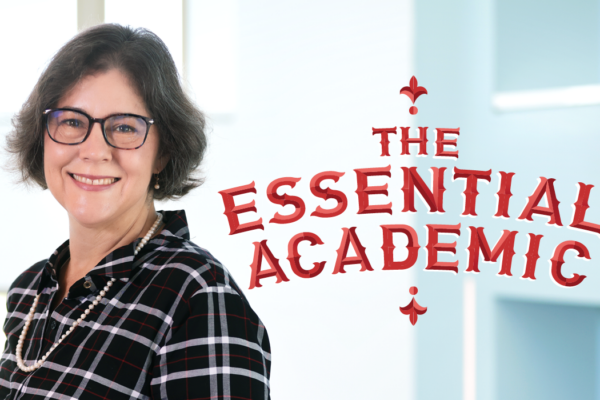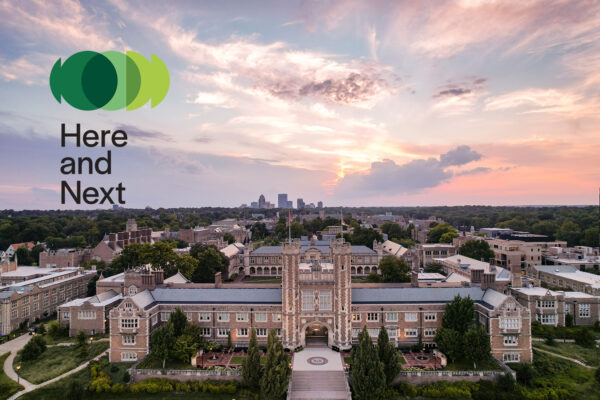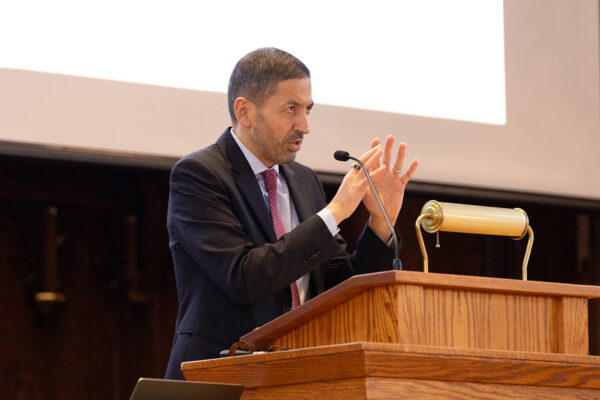On Oct. 3, 2022, as the world was continuing to emerge from the grips of a global pandemic, Washington University unveiled a bold and ambitious strategic plan called “Here and Next.”
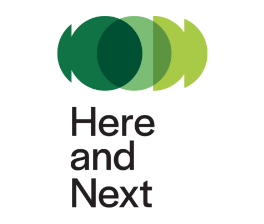
Developed through a process that included 18 months of listening, outreach and work sessions — most of it on Zoom — and incorporating feedback from thousands of students, faculty, staff, alumni and community partners, the plan mapped out a path forward for WashU for the next decade. And the chief facilitator, architect and champion was Provost Beverly Wendland, who drove the plan at every turn and beamed at every launch event, sporting a big smile and her signature green embroidered De La Cruz boots, a snappy, stylish pair from designer John Fluevog that she still wears from time to time.
Wendland, who in July 2020 arrived on the Danforth Campus from Johns Hopkins University, was all in for WashU, and she knew one of her first priorities would be to guide the strategic planning process. But no one saw the pandemic coming. Turns out, the lessons learned helping the university navigate COVID-19, combined with Wendland’s roll-up-the-sleeves-and-get-to-work attitude, helped set up the plan for success.
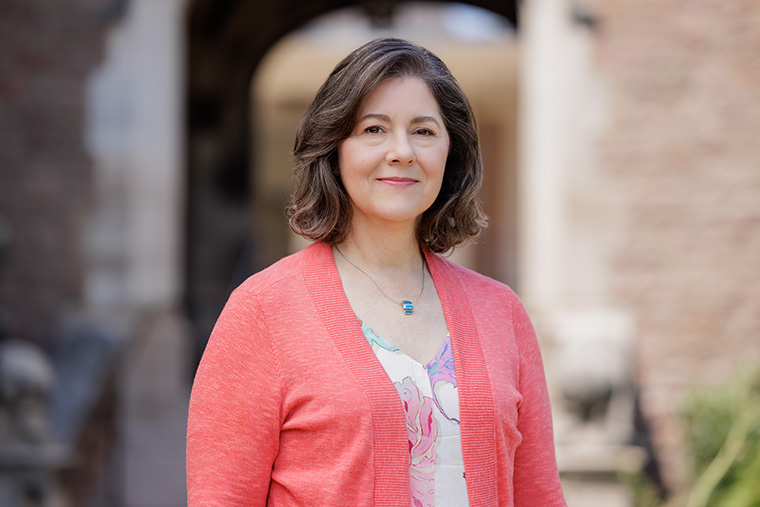
Now two-plus years in, WashU is a different place because of Here and Next, and there has been, at times, dizzying progress. Here’s an update on what changes have taken place thus far — and what transformations lie ahead.
In October 2022, you called the months leading up to it “the most exhilarating of your career.” Are you still feeling that way?
It’s been exciting to see some of the initiatives bust out and come to life. Giving birth to Here and Next in 2022 was a thrill, and the sort of “mini-births” that are happening now, the actual byproducts of the plan, are giving me a similar degree of satisfaction.
From the beginning, starting with the Board of Trustees meeting where the draft plan was discussed in depth, and the next meeting when the revised plan was approved, it was clear that the trustees were completely on board with supporting this vision that our community had developed together. At that time, it really did feel as if anything was possible. Then there was the outpouring of interest and enthusiasm with all the launch events that October.
What did you learn from how WashU navigated the pandemic that helped guide planning for Here and Next?
We learned a great deal, starting with the structure we set up to deal with the pandemic. We began with the executive committee and working groups and then added a coordinating committee for the strategic plan layered in between them. This comprised the co-chairs of the working groups and a few of the steering committee to provide some ‘horizontal’ connectivity in between the vertical nature of the committee structure. The coordinating committee helped the committees see what each was doing and identify the areas of overlap, synergies and sharing that allowed for synthesis across the whole plan as it developed. It saved us from redundant or even contradicting efforts.
The three pillars that have guided Chancellor Andrew D. Martin’s time here since his inauguration in 2018 are academic distinction, educational access, and “In St. Louis, For St. Louis.” How does Here and Next support those?
I was brought here to help support and enable those areas. So a lot of the strategic plan is in harmony with those priorities. There are three pillars — research, people, community — and within the pillars are also 17 initiatives, all happening at different paces. We’re keeping an eye on the metrics and tracking things all the time. I’m regularly reporting to the trustees, and we’re making sure we communicate to the community about what’s happening.
Creating the plan took 18 months of listening, outreach and working sessions. Can you give an example of an idea that came from a listening session that’s being developed today?
I can name many: the School of Public Health, the Center for the Environment, the successes happening with digital transformation, the Confluence Collaborative. All these things are happening for the WashU community — and then, ultimately, the community at large. Now that we have those structures in place, we’re turning our attention to the “people pillar” of the plan, looking at increasing our research activity on the Danforth Campus in conjunction with WashU Medicine. Each one of these is a little mini-victory. Take them all together, and every day feels invigorating.
Could you talk about the team you assembled to help you carry out various aspects of the plan? How important have they been to the success of its implementation?
The initial team doing the intensive planning and early implementation included myself; Joe MacDonald, who at the time was a part of the provost’s team; and then-Dean Mary McKay of the Brown School. The three of us worked in close concert, constantly asking ourselves: “Whom do we need to talk to? How do we plan for this? How do we maintain accountability for that?”
Having that tightly integrated group was important in the beginning, and I can’t imagine better partners. Joe exhibited skill sets I knew would be effective for helping to develop the strategic planning process from the start. Now, as senior associate dean for strategy and innovation, he has also helped Olin Business School with its new plan. And Mary was the perfect person, with her relational approach and the connectivity she had established guiding the Brown School’s strategic plan. She has been so effective in this process. Since that initial phase, the team has grown to include many talented professionals who have each contributed to the overall success of the plan in innumerable ways.
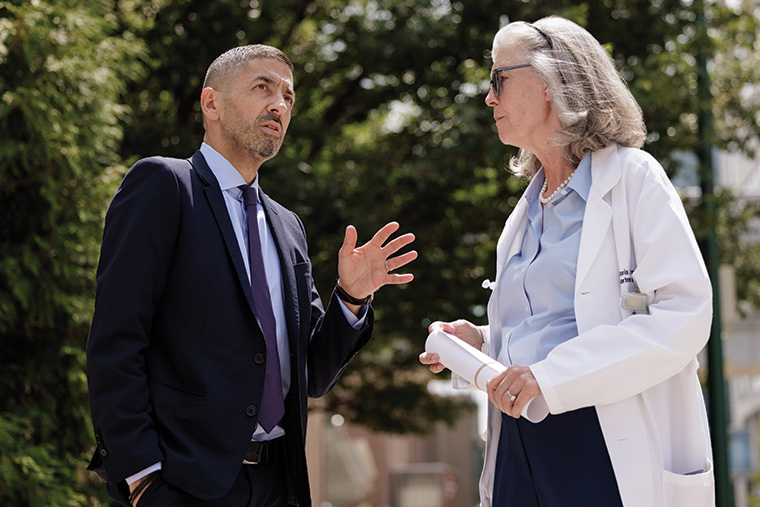
One of the underlying components of Here and Next is its collaborative nature. So many of the new initiatives involve multiple schools and groups within the community. Was that by design?
In 2024, we underwent our HLC (Higher Learning Commission) accreditation process. And I am super proud of one of the things the committee told us in our closeout meeting: The sense of collaboration on our campus was palpable. That felt awesome.
Collaboration was intentional from the beginning. For example, with the “In St. Louis, For St. Louis” working group, we made sure we had partners from the community. We had parents on committees looking at things that were directly impacting our students. And we were able to expand our vision when needed. The area of campus wellness, for example, was originally going to focus solely on student mental health. But during the pandemic, we recognized that the mental health of our entire community was at risk. So we broadened it from being focused on student mental health to overall campus wellness for our students, faculty and staff.
Another example was in career services. We turned that into being more about professional development for everybody — students, faculty and staff. We’re making sure our managers are well trained so our staff, the backbone of what we do every day, can have the best experience, too. It was important to me that our staff could see themselves in our plan.
Let’s talk about specifics. WashU is launching its first new school in a century with the School of Public Health. Did the lessons of the COVID-19 pandemic underscore the need to prioritize this initiative?
It became clear to me once I arrived from Johns Hopkins that a school of public health was the missing piece, and the pandemic made that more obvious. In the many meetings we had in those early days, Mary McKay was famous for saying that COVID makes everything worse. What she meant was that it made existing public health issues unignorable. Our work in those days helped peel away some of the territoriality that might have occurred in trying to make a universitywide change, such as taking all these disparate pieces that currently existed and finding a way to get them strategically aligned.
Our School of Public Health, at its core, is a strategic realignment aimed at growing our opportunities as an institution to do the work we truly are obligated to do in keeping our community healthy with the strength that we already have in place with WashU Medicine and the Brown School. And yet there are assets in every one of our schools that have something to contribute to this truly interdisciplinary and highly impactful area of public health.
We didn’t want to create another school of public health that is like all the others out there. After the pandemic, we wanted to examine where current ways of practicing public health failed us as a country. And so we are setting up a school that has a modern, 21st-century approach to public health. Ultimately, our goal is to make inroads into the challenges that are currently preventing our population from being as healthy as it can and should be — challenges such as providing healthy food, especially in underserved communities. And moving forward, it’s going to be more important than ever to be an example for, and train leaders in, public health communications in order to rebuild the public’s trust in this important work.
It’s amazing how fast this has come, too. you already have one of the top public health scholars in Dean Galea.
We could not have found a more perfect dean. The fact that we were able to recruit Sandro to join us here in St. Louis, well, I’m still almost in disbelief that we pulled it off. And we are fortunate to have his wife, Margaret Kruk, joining us at WashU as well.
And we’re building a brand-new school rather quickly in the world of academia, aren’t we?
Yes, we are! It can take seven to 10 years to start up a new school, and we’re doing it expeditiously, enabled by the incredible assets WashU already has in place. We already have the most highly ranked Master of Public Health program that’s not part of a standalone school of public health. This will be at the heart of our new school. We’re hitting the ground running with the collaborative manner in which the plan was developed, with people from across the university, including scholars like Bill Powderly, MD [the J. William Campbell Professor of Medicine and co-director of infectious diseases at WashU Medicine], and Deborah Haire-Joshu [the Joyce and Chauncy Buchheit Professorship in Public Health at the Brown School], who were on the team from the very beginning. And then Brad Evanoff, MD [the Richard A. and Elizabeth Henby Sutter Professor of Occupational, Industrial, and Environmental Medicine], came on board, along with so many others.
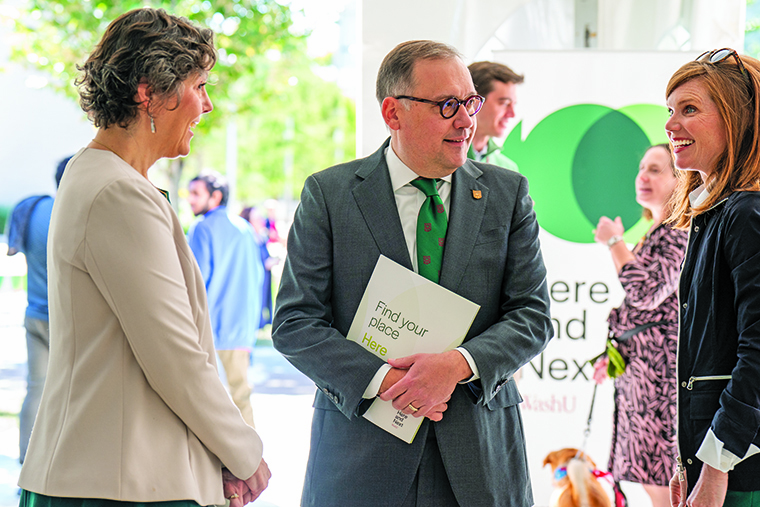
Artificial intelligence has exploded in the past two years, which makes the Digital Transformation initiative even more important and prescient. This one seems urgent. Is that fair?
AI and digital technologies are in the process of transforming pretty much everything that we do as human beings in society: how and what we teach, how we operate as a university, how we’re doing our research. All these aspects are going to be touched by digital transformation and enabled by AI. A couple of things are happening here with the establishment of the Digital Intelligence & Innovation (DI2) Accelerator, initially led by Philip R.O. Payne, who worked for two years to get the initiative off the ground. [Most recently, Betsy Sinclair and Nathan Jacobs were appointed assistant vice provosts for digital transformation and now are the faculty leads on the initiative.] One of its priorities is a new database that’s going to help faculty find new collaborators across disciplines, and it’s going to transform the way faculty find each other to collaborate.
Another thing I’m excited about is the Digital Solutions Studio. What they’ve been able to do is provide support to research faculty groups. The way I like to think about it is, if you’ve got a research project where you want to compare different databases and information contained within them, and then look for intersections and overlapping information among them, we’re going to help expedite that.
The Center for the Environment is taking on challenges like climate change, air pollution, access to clean water, food insecurity, biodiversity loss and infectious diseases. This must be exciting for you as a scientist.
Dan Giammar [the Walter E. Browne Professor of Environmental Engineering in the McKelvey School of Engineering] has delivered on what the mission and vision and goals were for this year: research and bringing together scholars in new configurations to realize collaborative work that otherwise wouldn’t have happened without the center. One amazing example of that is bringing together the aerosols group at McKelvey with faculty from WashU Medicine on a project to study how air pollution is contributing to colorectal cancer. There are going to be so many ways in which environmental health is going to be a linchpin of what the center will be supporting.
WashU has committed to being a good neighbor “In St. Louis, For St. Louis” through myriad ways, including through the revamping of the School of Continuing & Professional Studies (CAPS). Can you give an example of how CAPS is helping the region?
First, Dean Sean Armstrong was a fabulous hire. The team he’s assembled has been strong in helping develop a new mission and a new purpose. We could not have hired a better leader.
With CAPS, we want to make our WashU-level programming available for modern learners, adults in the community outside the 18–22 age range who have complicated lives and different needs. Developing a program that meets the needs of those who otherwise would have thought WashU was not a place for them was important. We are partnering with our local workforce to understand what skills St. Louis needs to meet the demand.
CAPS has also built on programs that already were established, like the Prison Education Project. With that, we’re looking to do more than just the education part of it; we’re looking to support reentry as well, developing programs that will help with education and jobs. And we recently received a grant from the Mellon Foundation to allow us to expand into the Missouri women’s prison in Vandalia.
Another aspect of being a good St. Louis partner is the St. Louis Confluence Collaborative for Community Engaged Research. What are some examples of things our neighbors will see through this?
This is a place, under the leadership of Bettina Drake, MD [professor of surgery in public health sciences at WashU Medicine], that will help us be the best partners we can be with our community. There’s a science of doing community engagement that begins with community-based research. We’re going to be helping our researchers understand how to better conduct this kind of research. We also want to be a front door for a community that might be seeking partnership with WashU but doesn’t know where to start. Just like the Digital Solutions Studio is poised to be an accelerator for different types of research, I see the Confluence Collaborative as potentially being a similar kind of accelerator for the St. Louis community.
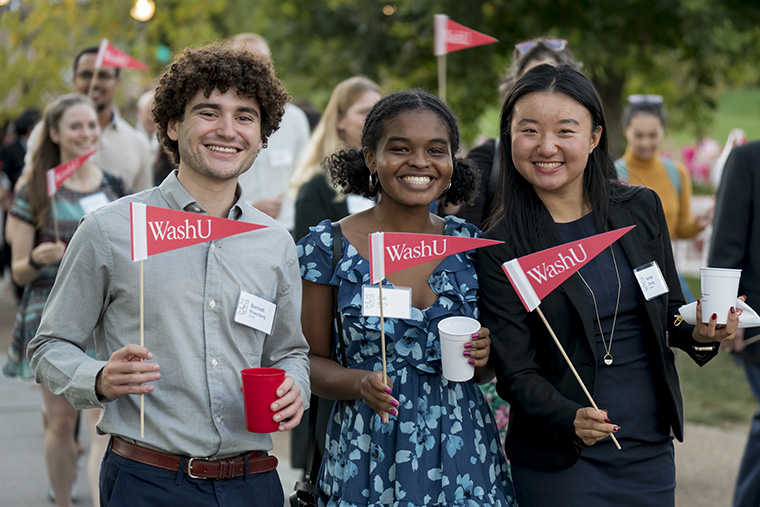
Let’s talk about our students. How will Here and Next affect them directly?
First, academic distinction and more research activity are going to create more opportunities for our undergrads to learn from and work in labs with some of the world’s leading researchers. Another area in which our students will benefit is in leadership training.
We want to train leaders who are focused on making sure that people understand how to work together in teams toward a common goal, one that is rooted in purpose and character and capacity. What’s helping drive that is the recent launch of the George and Carol Bauer Leaders Academy, which is already giving students — and faculty and staff — opportunities to develop the critical thinking and collaboration skills to get things done. (For more, see pg. 18.)
The plan is off and running, and it feels as if there’s a renewed energy on campus. Do you feel that, too?
As WashU’s chief academic officer, academic distinction is my guiding North Star. So things like improving our research administration so our faculty can more easily and successfully submit grant applications and updating our tenure and promotion policies are important. But I’m a scientist first. I understand, and will defend for my whole life, the importance of research at a university. Yet in our current culture, some segments of society are starting to question the value and benefit of higher education. We must be able to do work that society feels the impact of — and quickly.
Still, there is energy and momentum with Here and Next. I do feel as if there’s pretty good penetration and awareness of our plans within the community. The brand refresh will certainly help get the word out about all the great things about WashU. It’s been a wonderful convergence of things that are happening here.
So let’s ask the same question we asked you in 2021. Given what you know, not only about the state of the world but all the work put into Here and Next, where do you think WashU will be in 10 years?
I think that we are going to be recognized for our greatness.
